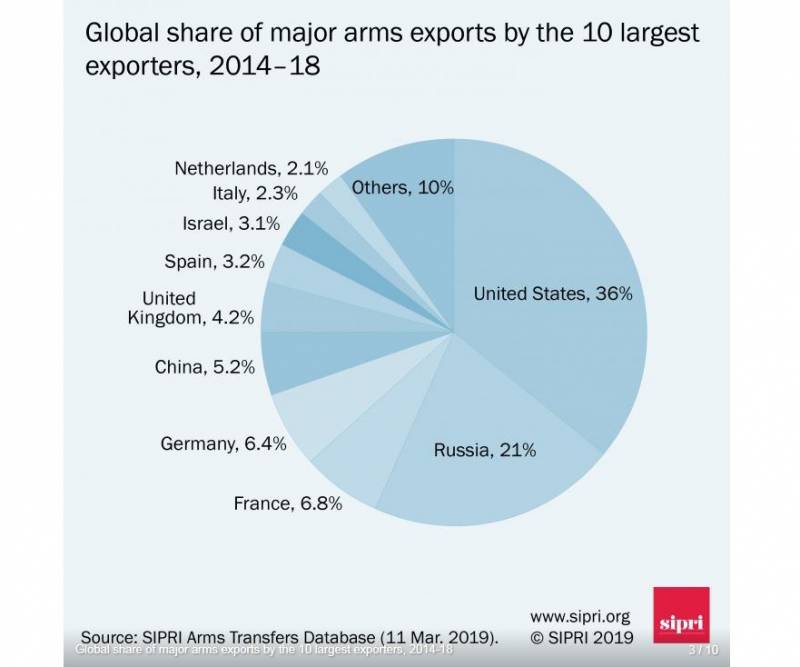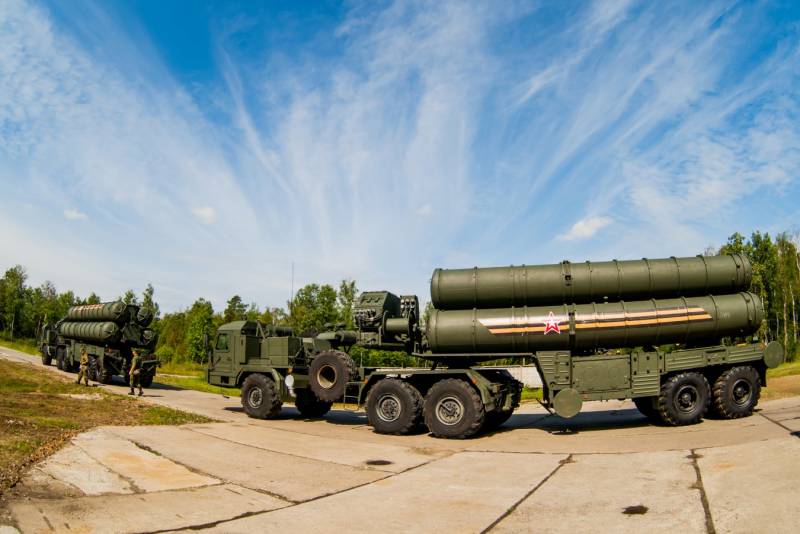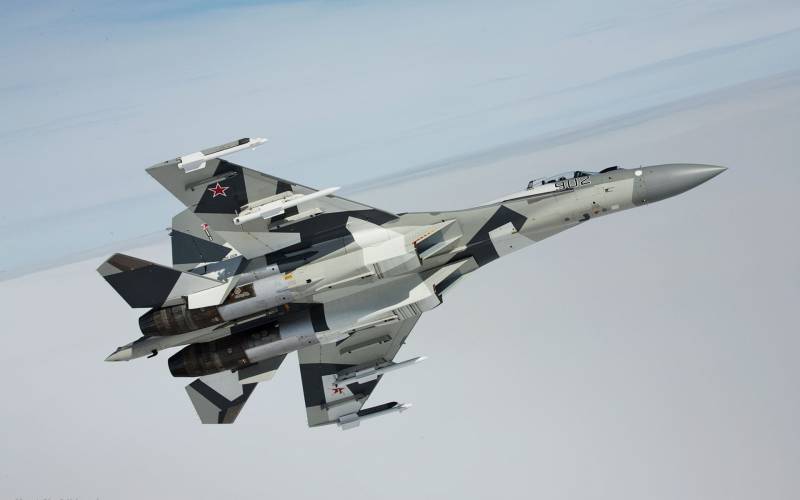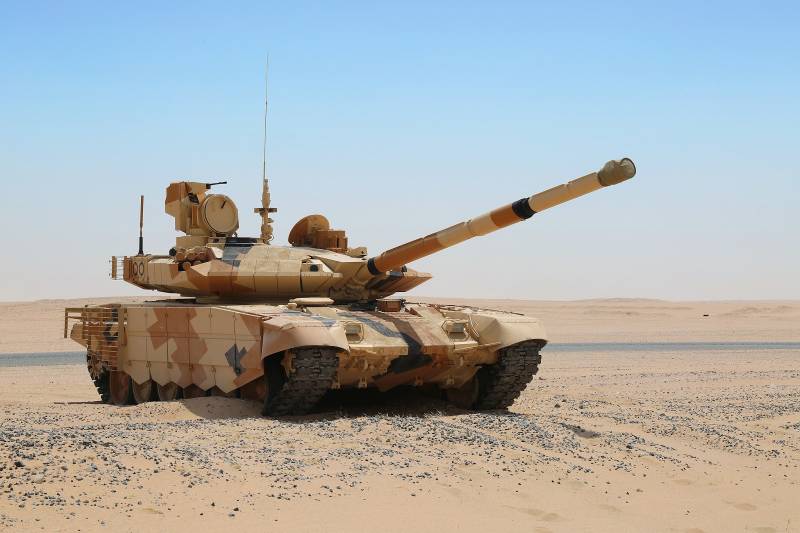Russia is losing ground in the international arms market. True?
The report states that the gap between the United States and other arms exporters is becoming more serious. So for the last five years, exports of American weapons grew by 29 percent compared to 2009-2013's. The share of states in the total volume of world arms supplies has grown from 30 percent to 36 percent. According to Dr. Oda Fleran, who holds the position of Director of the SIPRI Arms and Military Expenditures Program, in recent years, the United States has further strengthened its position as a leading international arms supplier. During this period, the states supplied weapons to 98 from various countries. At the same time, SIPRI indicates that the export of Russian weapons has decreased over the last five years by 17 percent compared to 2009-2013's figures.
The reduction in the volume of supplies is associated primarily with a decrease in imports of Russian weapons in two countries - Venezuela and India. These two countries have seriously reduced arms purchases. So in Venezuela for understandable reasons (the country is in the deepest social, economic and political crisis), the import of weapons for 2014-2018 year decreased immediately by 83 percent compared to 2009-2013 year. India’s arms imports have declined less significantly — by 24 percent in 2014-2018. But such a fall seems to be serious, since during this period imports of weapons from Russia accounted for 58 percent of the total Indian imports of weapons. Naturally, such a dynamic could not but reflect on the indicators of Russian arms exports. At the same time, the growth in the supply of American weapons is explained by the appetites of Saudi Arabia, which increased the volume of arms imports by 192 percent at once, becoming the world's largest importer of weapons. Also, the success of the Americans is connected with Australia, which reached the 4-e place in the world in the import of arms, increasing purchases in this area by 37 percent. This is largely due to the renewal of its aviation fleet by Australia. The country has acquired fifth-generation F-50A fifth-generation F-35A fighter aircraft in the United States, which should replace the outdated Australian F-18 Hornet fighter. The value of this transaction alone is estimated by experts at 17 billion dollars.
In general, the situation with arms exports in the world has not changed significantly; the top five exporting countries have remained unchanged. Five major arms exporters account for more than 75 percent of total shipments. In 2014-2018, the main five arms exporters were as follows: United States (36 percent), Russia (21 percent), France (6,8 percent), Germany (6,4 percent), China (5,2 percent).
It is worth noting that in Russia, any information that relates to the export of weapons is perceived acutely. And this has its own explanation. Today, arms exports are one of our country's business cards, Russian weapons are known all over the world. At the same time, the supply of weapons is not only international prestige, but also serious financial investments in the Russian economy. In the structure of Russian exports, the lion’s share is represented by the supply of fuel and energy products, while their share in recent years has been constantly growing, exceeding 60 percent in the structure of exports. Another 10 percent gives the supply of metals and products from them. Approximately equal volumes fall on the products of the chemical industry and the supply of machinery and equipment, which also account for approximately 6 percent of Russian exports. Of these 6 percent, at least two thirds are attributed to military products.
It would seem that the proportion is not so significant. However, it is very important, as today weapons and military equipment are, of course, the most high-tech article of Russian exports on the international market. Russian weapons are traditionally high-tech products with high added value. Moreover, it directly competes with similar products produced by highly developed countries with a strong economy and looks quite convincingly in this competitive struggle.
And here we return to the beginning of our article and the published SIPRI study. Does Russia really lose its position in the international arms market? The answer will be this - rather not lose, than lose. Of great importance here is the way the report is prepared, prepared by the Stockholm International Peace Research Institute. In the explanation to it, it is written in black and white that this study reflects the volume of arms supplies (including sales, military aid, as well as licenses for military production), but does not reflect the financial value of the transactions. Since the volume of supplies of weapons and military equipment can vary from year to year, the institute provides reports for a five-year period, which allows for a more balanced analysis.
Here we come to the point. In value terms, Russian arms exports did not sag. In recent years, our country annually concludes contracts in the defense sector for about 15 billion dollars. The number of contracts for Rosoboronexport in the past three years, changes very little, the achieved result is maintained, however, and there is no significant growth. Rosoboronexport’s portfolio of contracts exceeds 50 billion dollars with a maturity of 3-7 years, which provides enterprises of the Russian MIC with work.
In this regard, there are no drawdowns in the export of Russian weapons. The problem is the methodology of the SIPRI Institute itself, which does not fix the financial value of transactions. As a good example, a comparison can be made: Russia can supply a foreign customer with 6-8 S-300 air defense divisions or 2 S-400 Triumph air defense divisions. The transaction value will be comparable, and the volume of deliveries will vary significantly. The same applies to the main combat tanksIt is one thing to supply the customer with the latest and most modern serial Russian T-90MS tank at the moment, or take 10 first-series T-72 tanks from army storage bases. Financially, this will probably be the same amount, but it is impossible to compare them qualitatively.
At the same time, the C-400 “Triumph” anti-aircraft missile system is currently the locomotive of the Russian defense industry and the most successful product in the Russian defense portfolio. Deliveries of this system to foreign customers more than cover the losses from the cessation of deliveries of military products to Venezuela, which in the foreseeable future will not be able to buy any modern weapons not only of Russian origin, but also of anyone else. The buyers of the new Russian anti-aircraft missile system are Turkey (the cost of the transaction is over 2 billion dollars), China (the transaction is valued at more than 3 billion dollars) and India, which is ready to purchase 5 regimental kits immediately (the transaction is estimated at more than 5 billion dollars) . At the same time, India signed a contract, even despite the threat of US sanctions. According to the American channel CNBC, which referred to its sources in American intelligence, interest in the Russian air defense system C-400 is shown by at least 13 states, primarily in the countries located on the Arabian Peninsula, in North Africa and Southeast Asia.
True, in the future, American sanctions are indeed capable of making the life of Russian defense-industrial complex enterprises more difficult. So the Russian manufacturers of ammunition are already suffering losses from sanctions, losing about 10 billions of rubles of their revenue per year. Before the sanctions, 80 percent of Russian products went to the markets of America and European countries that allowed civilian weapons. In the United States alone, more than 390 of millions of firearms are in the hands of the population, the loss of this market was a sensitive blow to Russian ammunition factories.
Another best-known sign of sanction pressure was a suspended contract for the supply of T-90MS and T-90MSK tanks (command version) to Kuwait. This state was to become the starting customer of new Russian main battle tanks, the prototypes of which were tested in the Kuwait desert in the 2014 year. According to information disclosed by Uralvagonzavod, the priority directions of the military-technical cooperation of the company for the 2017 year included the completion of a contract for the supply of Kuwait 146 main battle tanks T-90MS / MSK. At the same time, Kuwaiti officials emphasize that this contract is not terminated, but temporarily postponed. According to unofficial information, the contract was suspended directly under US pressure on Kuwait’s authorities, which has so far been the most noticeable result of US sanctions pressure aimed at Russia’s military-technical cooperation with foreign customers after the adoption of the CAATSA law (On Countering America’s Opponents in August 2017) through sanctions. ”)
At the same time, such pressure on the main buyers of Russian armaments seems simply impossible. Secondary sanctions do not overlap the prospects for cooperation with Russia in the military-technical sphere for such states as India and China. Even US allies, such as Saudi Arabia, are showing an open interest in Russian weapons and can ignore the possibility of secondary sanctions, playing with the US in the economic sphere on an equal footing. And for developing countries in Africa or Southeast Asia, the rejection of Russian weapons and components will mean the degradation of their armed forces, which is also unacceptable for them. Russia itself, together with its partners, is looking for ways to circumvent the sanctions, in particular, using settlements in national currencies or such an exotic option as with Indonesia, where barter in the form of transfer of a certain stock exchange to Russia was included in the sale of Su-35 multi-role fighters goods. In a word, it’s still premature to say that Russia is losing its position in the international arms market, especially considering the financial aspect of the deals being made.




Information